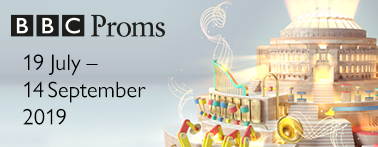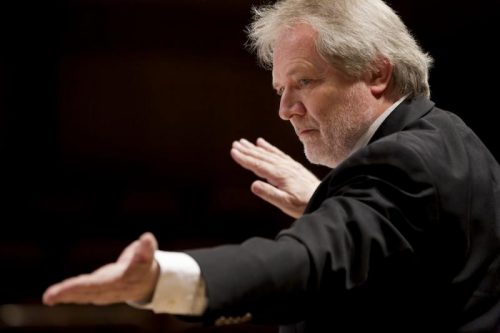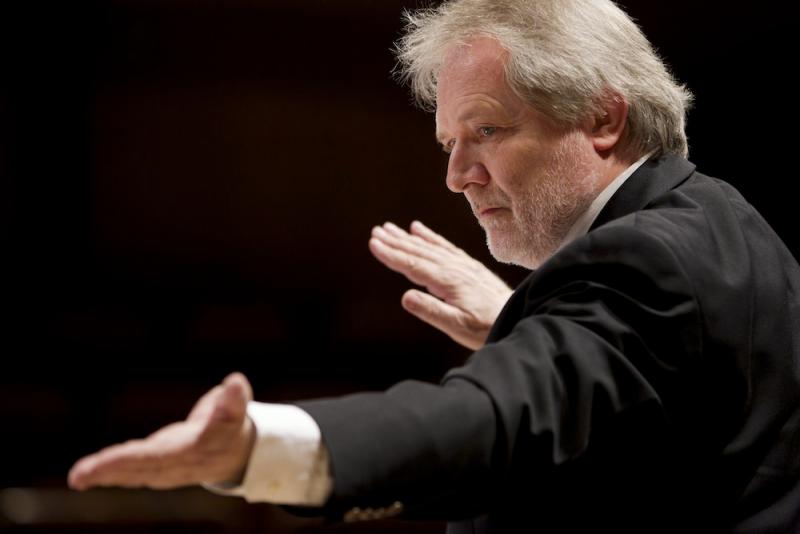
 United Kingdom BBC PROM 8 – Invitation to the Dance: Isabelle Faust (violin), BBC Symphony Orchestra / Péter Eötvös (conductor). Royal Albert Hall, London, 24.7.2019. (AK)
United Kingdom BBC PROM 8 – Invitation to the Dance: Isabelle Faust (violin), BBC Symphony Orchestra / Péter Eötvös (conductor). Royal Albert Hall, London, 24.7.2019. (AK)

Debussy – Prélude à l’après-midi d’un faune
Péter Eötvös – Alhambra (violin concerto) (BBC co-commission with Festival Internacional de Música y Danza de Granada, Orchestre de Paris and Stiftung Berliner Philharmoniker: UK premiere)
Bartók – Dance Suite
Stravinsky – The Firebird – suite (revised version, 1919)
Sadly I overlooked this significant concert and so missed being there; my report is based on listening to it on iPlayer.
The coherence of the programme was meant to be dance on one hand and Henry Wood’s championing new music on the other. Both elements are obviously true for three of the pieces but Eötvös’s violin concerto may be considered as the odd one out: it is not a dance although it now received its UK premiere at the Proms. For me the coherence was provided by Bartók in three stages: influence on Bartók; Bartók composition and Bartók’s influence on future generations. Bartók was influenced by Debussy (see his Bluebeard’s Castle) and was very complementary in several of his writings about Stravinsky. Arguably, some of Bartók’s compositions were influenced by Stravinsky (like, for instance, his Second Piano Concerto). Clearly, many composers were influenced by Bartók but, for me, the best representative of the Bartókian essence is the composer/conductor/pianist Péter Eötvös.
Alhambra, Eötvös’s Violin Concerto No.3, was dedicated to violinist Isabelle Faust and conductor Pablo Heras-Casado, the two of whom (and the Mahler Chamber Orchestra) gave the first performance of the concerto on 12th July – a mere twelve days before its UK premiere – as the concluding event at the Granada Festival 2019. The piece is inspired by these two musicians but also by the Palace Alhambra in Granada.
Because of Granada, the most important musical note in the piece is the note G which acts as a gravitational centre. The main theme of the piece, appearing three times, is constructed from notes following the letters of A-L-H-A-M-B-R-A. The letters become musical pitches if one uses the combination of German and Italian pitch names or, going back in musical history, some of the Guidonian pitch names. In English translation, these are the musical pitches of the main theme: A – A (A=la) – B (B=h ) – A – E (E=mi) – Bflat (Bflat=b) – D (D=re) – A.
The theme appears three times: at the beginning (beautifully shaped by the solo violin), at the conclusion and somewhere in-between. This seems to suggest a classical architecture for the structure of the piece. Eötvös defines the piece as a Promenade. It is a walk by the protagonist – the solo violin – among the wonders of the Palace Alhambra. The violin is accompanied by the mandolin (acting as Sancho Panza) in scordatura; its eight string are tuned to seven pitches: F-G-D-E-A-B-E-E (instead of the customary mandolin tuning of G-G-D-D-A-A-E-E). During its walk through the Promenade, the violin encounters a variety of instruments who enter into dialogues with it: horns, trombones, piccolos, bells, pizzicato strings, bowed double bass(es), and even a baritone saxophone. The percussion instruments are plentiful and colourful, representing the Andalusian flavour. There are only two percussion players but they play a vibraphone (with motor), 3 triangles (low, middle, high), claves (high), 2 maracas (middle, high), crotales, Glockenspiel, bells (f, g, g, a), xylophone, and tamburo basco (with high jingles). With the added participation of woodwind, brass, celesta, harp and strings, the solo violin (and the commentator mandolin) have many discussions on their walk.
The solo violin is constant throughout. It is lyrical as well as virtuoso (but always violin-like). Variety is effortlessly flowing, making listening exciting and enjoyable. Eötvös respects the melodic nature of the violin but also uses all legitimate tricks of the instrument: glissando, harmonics, double strings etc. The concerto concludes with the beautiful, lyrical solo violin statement: afterwards the audience at this UK premiere was silent for several seconds. They were still deep in their Promenade walk or perhaps they were astonished by the performance of violin soloist Isabelle Faust, composer/conductor Péter Eötvös, mandolin player James Ellis and the entire orchestra.
The founder of the Proms, Henry Wood, called new works he put into his programmes his ‘novelties’, and to celebrate his 150th birthday three of them received spirited, passionate yet disciplined performances. In the Debussy piece, Daniel Pailthorpe’s extensive solos on his wooden flute were not only beautiful but highly appropriate. What else would a faun play if not a wood instrument? No disrespect to the excellent oboe soloist but his entry following the wooden flute initially felt a bit steely. However, all was well with the oboe as well as the whole orchestra. In Eötvös’s interpretation, the passion/desire of the faun was as clear as it is in Debussy’s detailed instructions for tempi and dynamics.
I heard Eötvös conduct Bartók’s Dance Suite on earlier occasions: his take on the piece is never the same, he is re-creating every time. He does the same with his own compositions: in a recent interview with Jeffrey Arlo Brown (VAN, 18/7/2019), Eötvös explains his never ending work on his existing compositions. His respect for other compositions (like the Dance Suite and The Firebird) as well as for his players is immense. He conducts without a baton (like his one-time mentor and friend Boulez) but with great sensitivity, intimate knowledge of all details of the score and great passion within integrity. On conclusion of The Firebird I burst into tears.
I was disappointed about the PromsPlus talk recorded at the Imperial College Union in front of an audience and broadcast during the interval of the concert. Host Hannah Conway asked pertinent questions about Bartók; her highly respected guests (Professors Levi and Simeone) gave no doubt well-meaning but inaccurate answers throughout. For instance, it was stated that etnomusicology was Bartók’s second career. Not quite; in his last ten years of his life he did receive renumeration for his work on folk music but for thirty years he passionately collected and analysed folk material at his own expense. Both professors speculated that Bartók’s compositions were pure Bartók, the folk music influence was not specific. Yet Bartók clearly specified in his writings the three ways by which he incorporated folk music into his compositions. The Dance Suite was not ‘made up’, as the professors suggested; folk music influence is evident. Bartók did not collect folk music to assert his Hungarian identity (as was stated in one part of the programme): he collected Hungarian, Romanian, Slovakian, Serbian and even Berber folk music (as was mentioned later in the programme). I am also uneasy about the professors’ comments about Bartók’s affair with another woman while still married. Having read Bartók’s writings and having been his younger son Peter’s closest friend for over twenty years, I can assure the professors that Bartók was a deeply honourable, old-fashioned man who would not cheat on anybody in any way.
Returning to Péter Eötvös, I recall that exactly sixty years ago I was an aspiring fourteen-year old cellist getting ready for a solo appearance. The pianist, a teacher at the Conservatoire, fell ill and could not attend. But his very mature, highly skilled fifteen-year old pianist son stepped in and saved my concert. I remember thinking that he would get far. He did: he is Péter Eötvös!
Agnes Kory

Dear Agnes, just a little mistake in your post, I think : A-L-H-A-M-B-R-A isn’t the main theme given 3 times by the violin (at the beginning, middle and end), but appears at the H letter of the score.
From Agnes Kory,
Dear Angèle,
Thank you for your comment. I now listened again to the broadcast and, indeed, you are right: the A-L-H-A-M-B-R-A pitches do not appear either at the beginning or at the end. My error stems from hearing the concerto only once, from not having access to the score and from my misunderstanding of various interviews/statements. I now checked with the composer and he clarified the issue for me.
The concerto includes an ‘Alhambra-Melody’ as well as the ‘Alhambra- Motive’ (cryptogram).
The Melody, which starts the concerto, is longer and appears four times: twice without any accompaniment, that is at the beginning and at the end, furthermore twice within orchestral context.
The Motive (cryptogram) consists of eight notes; it first appears at figure H and later it gets various treatments such as, for instance, inversions.
For the public at large the composer identifies the starting and concluding solo melody as the ‘Alhambra-Melody’.
Thank you again and best regards: Agnes Kory
Thank you very much for your answer and your explanations!
Best regards,
Angèle